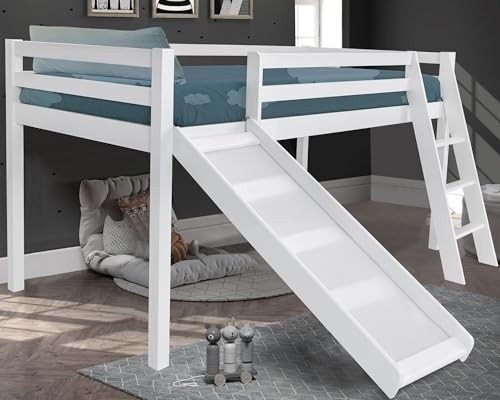Exploring Bunk Beds: A Comprehensive Guide
Bunk beds have long been a staple in kids's bed rooms, dorm rooms, and even homes with limited space. Not only do they supply a practical sleeping option, however they also develop an enjoyable and creative environment for children and a great space-saver for adults and households. This post will check out whatever you need to learn about bunk beds, from types and materials to safety tips and buying guidance.
Table of Contents
- Kinds Of Bunk Beds
- Conventional Bunk Beds
- Loft Beds
- Triple Bunk Beds
- L-Shaped Bunk Beds
- Product Options
- Wood
- Metal
- Safety Considerations
- Purchasing Guide
- Frequently asked questions
Types of Bunk Beds
Bunk beds can be found in different designs to match various needs and choices. Here's a breakdown of the most common types:
Conventional Bunk Beds
Traditional bunks usually feature 2 beds stacked vertically on top of one another. These beds are perfect for siblings sharing a room or for making the most of sleeping space in guest rooms.
Loft Beds
Loft beds stand similarly to conventional bunk beds however do not have a lower sleeping area. Rather, they frequently integrate a desk or seating location underneath, making them a great choice for small spaces requiring multifunctionality.
Triple Bunk Beds
Triple bunk beds are created for 3 residents, with beds stacked in a three-tier configuration. These are less typical however can be a fun solution for big families or sleepovers.
L-Shaped Bunk Beds
With one bed positioned horizontally and the other vertically, L-shaped bunk beds are often equipped with extra features such as desks or storage drawers and can match corner spaces in a space.
Comparison of Bunk Bed Types
| Bed Type | Perfect Use | Description |
|---|---|---|
| Conventional | Shared bed rooms or guest rooms | Two beds stacked vertically |
| Loft | Small spaces requiring multi-purpose space | Upper bed with open space underneath |
| Triple | Big households or sleepovers | Three beds stacked vertically |
| L-Shaped | Corner or versatile spaces | A mix of vertical and horizontal beds |
Product Options
Bunk beds are manufactured from different products, with wood and metal being the most typical. Each product has its advantages and disadvantages.
Wood
- Durability: Generally robust and can withstand years of use.
- Aesthetic Appeal: Offers a classic appearance that can blend with different decorations.
- Weight Capacity: Typically stronger; can support much heavier weights.
- Downsides: May be more pricey than metal options and can be prone to scratches.
Metal
- Strength: Generally lightweight and simple to move but still strong.
- Modern Design: Often is available in smooth designs, making it appealing for modern spaces.
- Economical: Usually cheaper than wood alternatives.
- Disadvantages: Can be cold to the touch in winter seasons and may not have the very same visual appeal for some buyers.
Security Considerations
When it concerns bunk beds, safety can not be overlooked. Here are key safety tips to keep in mind:
- Guardrails: Ensure that the leading bunk has guardrails on both sides to prevent falls.
- Sturdy Construction: Check for a solid construct and strong products to stand up to weight and movement.
- Weight Limit: Adhere to the producer's weight limit for both the upper and lower bunks.
- Ladder Design: Choose bunks with a safe, easy-to-climb ladder and avoid any sharp edges or rungs.
- Age Restrictions: Most producers recommend that children under the age of six need to not oversleep the upper bunk.
Buying Guide
When searching for bunk beds, consider the list below elements to find the very best suitable for your needs:
- Space Availability: Measure the space size and ceiling height, guaranteeing there is adequate space for the leading bunk.
- Bed Size: Decide in between twin, complete, or bigger sizes based on your requirements and the size of the space.
- Design Preference: Consider the total decor of the bed room to discover an ideal design.
- Relieve of Setup: Look for a bunk bed that is uncomplicated to assemble.
- Spending plan: Bunk beds come in numerous price varieties, so identify a budget before starting your search.
Frequently asked questions
1. What is the recommended age for children to sleep on the top bunk?
Kids aged six and older are typically advised to sleep on the leading bunk to minimize the threat of falls.
2. How can I make my bunk bed safer?
To enhance security, ensure guardrails are effectively set up and examine that the bed is put on a flat surface. In addition, motivate children to utilize the ladder carefully.
3. Can I convert a bunk bed into 2 separate beds?
Lots of bunk beds are designed to be convertible. Inspect the manufacturer's requirements for convertibility features.
4. What accessories are available for bunk beds?
Typical accessories include beddings, storage drawers, staircases rather of ladders, and tented canopies for an enjoyable visual appeal.
5. How do I maintain my bunk bed?
Regular checks for loose screws or structural integrity can assist make sure safety. Dust the bed regularly and clean spills quickly to keep the products in good condition.
Bunk beds are versatile and a space-efficient solution for various living situations, from children's rooms to guest accommodations. With Bunk Beds Children's of styles and materials readily available, prospective purchasers have a wealth of alternatives to consider, guaranteeing a combination of usefulness and looks. By focusing on security and following the suggestions described in this guide, individuals can discover the best bunk bed that fits their space and lifestyle, all while creating a satisfying sleeping environment.

